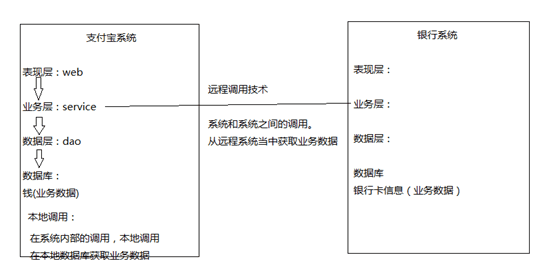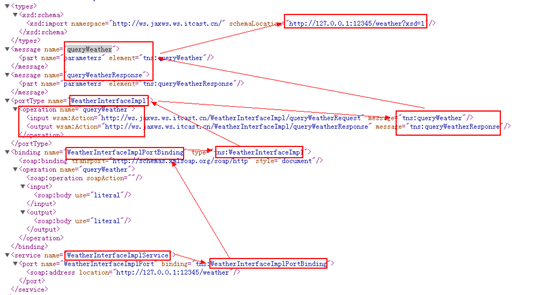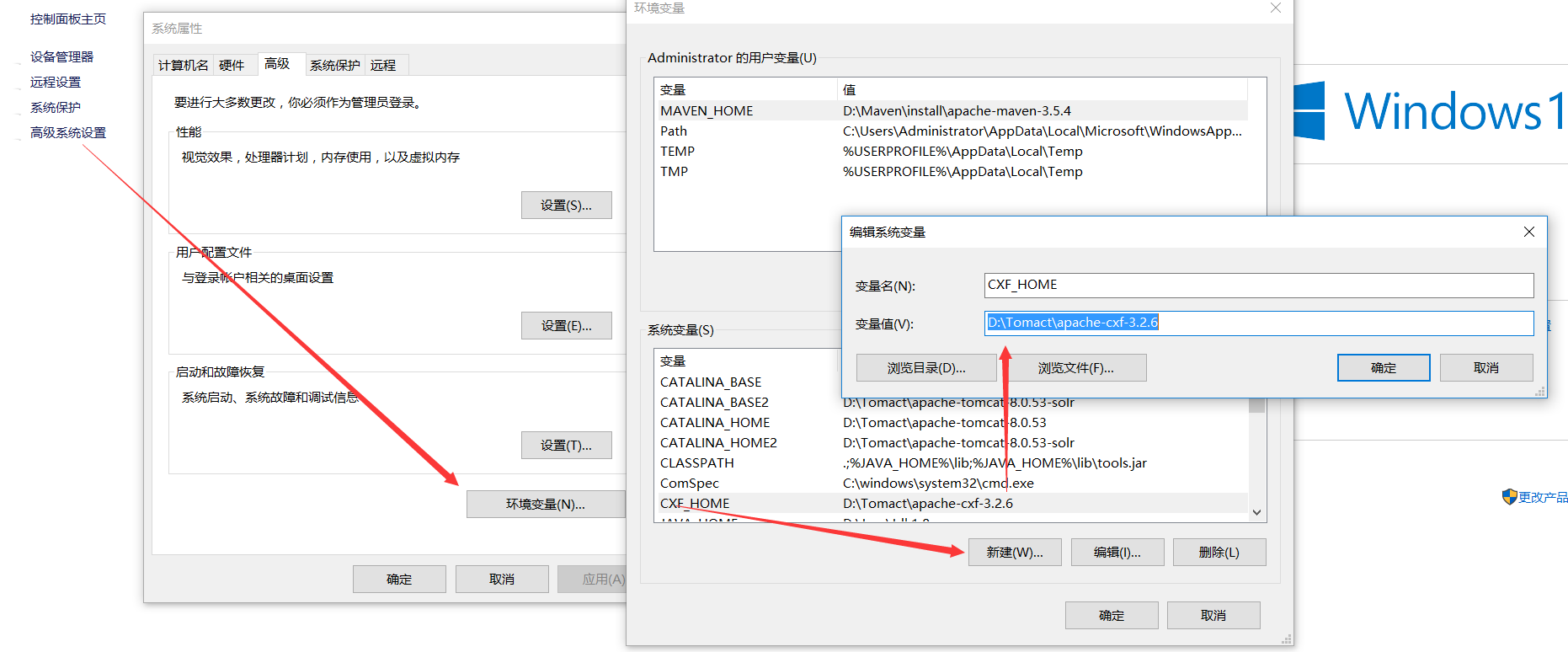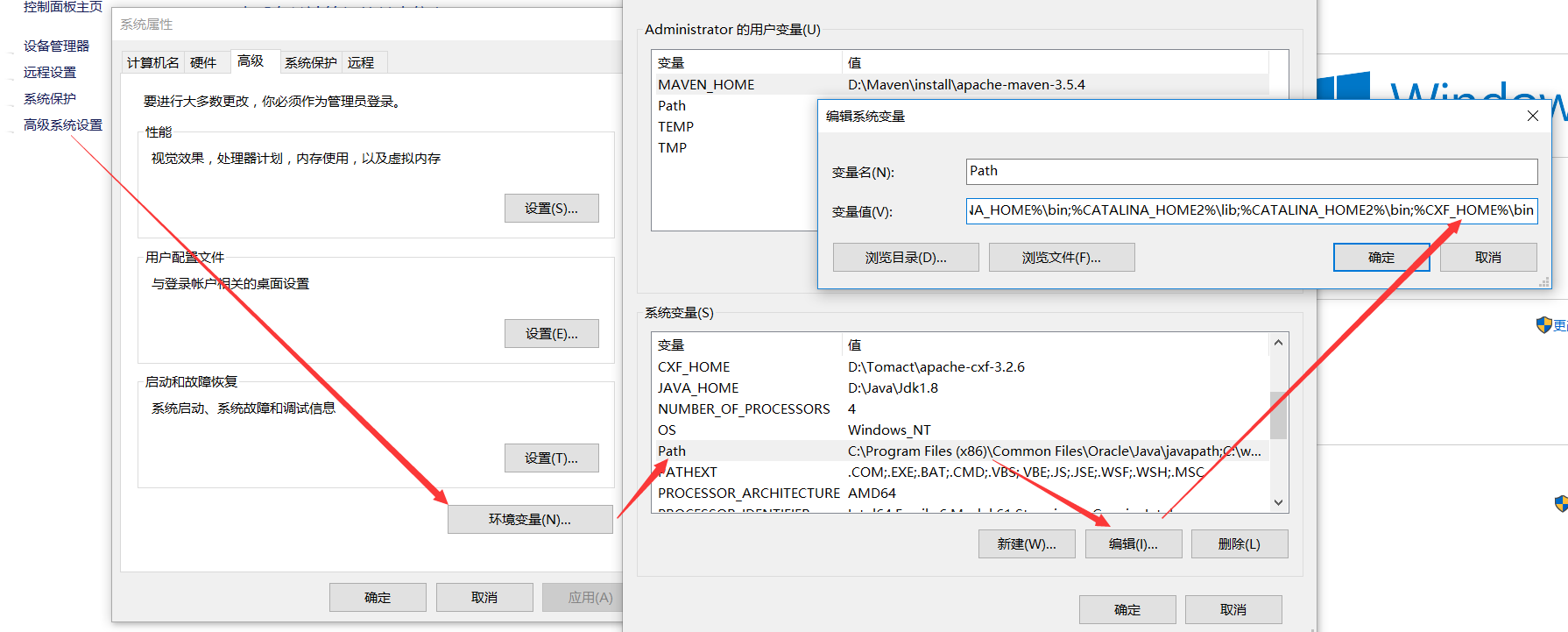WebService与CXF
一:简介
1 什么是webservice
一言以蔽之:WebService是一种跨编程语言和跨操作系统平台的远程调用规范。
比如,amazon,天气预报系统,淘宝网,校内网,百度等把自己的系统服务以webservice服务的形式暴露出来,让第三方网站和程序可以调用这些服务功能,这样扩展了自己系统的市场占有率
从表面上看,WebService就是一个应用程序向外界暴露出一个能通过Web进行调用的API,也就是说能用编程的方法通过Web来调用这个应用程序。我们把调用这个WebService的应用程序叫做客户端,而把提供这个WebService的应用程序叫做服务端。我们要做的就是开发Webservice接口,调用WebService接口
从深层次看,WebService是建立可互操作的分布式应用程序的新平台,是一个平台,是一套标准。它定义了应用程序如何在Web上实现互操作性,你可以用任何你喜欢的语言,在任何你喜欢的平台上写Web service ,只要我们可以通过Web service标准对这些服务进行查询和访问。
2 什么是远程调用技术
远程调用数据定义:是系统和系统之间的调用

Webservice是使用Http发送SOAP协议的数据的一种远程调用技术
Webservice要开发服务端
Webservice要开发客户端
Webservice客户端开发需要阅读服务端的使用说明书(WSDL)
3:Webservice的优缺点
优点:
发送方式采用http的post发送,http的默认端口是80,防火墙默认不拦截80,所以跨防火墙
采用XML格式封装数据,XML是跨平台的,所以webservice也可以跨平台。
Webservice支持面向对象
缺点:
采用XML格式封装数据,所以在传输过程中,要传输额外的标签,随着SOAP协议的不断完善,标签越来越大,导致webservice性能下降
二:入门程序
需求
服务端:发布一个天气查询服务,接收客户端城市名,返回天气数据给客户端
客户端:发送城市名称给服务端,接收服务端的返回天气数据,打印
实现
服务端:
开发步骤:
l 第一步:创建SEI(Service Endpoint Interface)接口
public interface WeatherInterface {
public String queryWeather(String cityName);
}
第二步:创建SEI实现类,在实现类上加入@WebService
@WebService//@WebService表示该类是一个服务类,需要发布其中的public的方法
public class WeatherInterfaceImpl implements WeatherInterface {
@Override
public String queryWeather(String cityName) {
System.out.println("from client..."+cityName);
String weather = "晴";
return weather;
}
}
第三步:发布服务,Endpoint发布服务,publish方法,两个参数:1.服务地址;2.服务实现类
public class WeatherServer {
public static void main(String[] args) {
//Endpoint发布服务
//参数解释
//1.address - 服务地址
//2.implementor - 实现类
Endpoint.publish("http://127.0.0.1:12345/weather", new WeatherInterfaceImpl());
}
}
第四步:测试服务是否发布成功,通过阅读使用说明书,确定客户端调用的接口、方法、参数和返回值存在,证明服务发布成功。
WSDL地址:服务地址+”?wsdl”
客户端:
开发步骤
第一步:wsimport命令生成客户端代码
wsimport -s . http://127.0.0.1:12345/weather?wsdl
第二步:根据使用说明书,使用客户端代码调用服务端
Ø 第一步:创建服务视图,视图是从service标签的name属性获取
Ø 第二步:获取服务实现类,实现类从portType的name属性获取
Ø 第三步:获取查询方法,从portType的operation标签获取
public class WeatherClient {
public static void main(String[] args) {
//创建服务视图
WeatherInterfaceImplService weatherInterfaceImplService = new WeatherInterfaceImplService();
//获取服务实现类
WeatherInterfaceImpl weatherInterfaceImpl = weatherInterfaceImplService.getPort(WeatherInterfaceImpl.class);
//调用查询方法,打印
String weather = weatherInterfaceImpl.queryWeather("北京");
System.out.println(weather);
}
}
三:WSDL
WSDL及web服务描述语言,他是webservice服务端使用说明书,说明服务端接口、方法、参数和返回值,WSDL是随服务发布成功,自动生成,无需编写,为用户提供详细的接口说明书
好比我们去商店买东西,首先要知道商店里有什么东西可买,然后再来购买,商家的做法就是张贴广告海报。 WebService也一样,WebService客户端要调用一个WebService服务,首先要有知道这个服务的地址在哪,以及这个服务里有什么方法可以调用,所以,WebService务器端首先要通过一个WSDL文件来说明自己家里有啥服务可以对外调用,服务是什么(服务中有哪些方法,方法接受的参数是什么,返回值是什么),服务的网络地址用哪个url地址表示,服务通过什么方式来调用。
WSDL(Web Services Description Language)就是这样一个基于XML的语言,用于描述Web Service及其函数、参数和返回值。
一些最新的开发工具既能根据你的Web service生成WSDL文档,又能导入WSDL文档,生成调用相应WebService的代理类代码。
WSDL文件保存在Web服务器上,通过一个url地址就可以访问到它。客户端要调用一个WebService服务之前,要知道该服务的WSDL文件的地址。WebService服务提供商可以通过两种方式来暴露它的WSDL文件地址:1.注册到UDDI服务器,以便被人查找;2.直接告诉给客户端调用者。
文档结构:

阅读从下往上:

四:SOAP
SOAP是一种webService平台技术;
SOAP即简单对象访问协议,他是使用http发送的XML格式的数据,它可以跨平台,跨防火墙,SOAP不是webservice的专有协议。
SOAP协议 = HTTP协议 + XML数据格式
WebService通过HTTP协议发送请求和接收结果时,发送的请求内容和结果内容都采用XML格式封装,并增加了一些特定的HTTP消息头,以说明HTTP消息的内容格式,这些特定的HTTP消息头和XML内容格式就是SOAP协议。
当然除了SAOP还有其他WebService技术,XML+XSD,SOAP和WSDL就是构成WebService平台的三大技术。

l 必需有 Envelope 元素,此元素将整个 XML 文档标识为一条 SOAP 消息
l 可选的 Header 元素,包含头部信息
l 必需有Body 元素,包含所有的调用和响应信息
l 可选的 Fault 元素,提供有关在处理此消息所发生错误的信息
五:REST
https://www.cnblogs.com/loveis715/p/4669091.html
REST 是一种软件架构模式,只是一种风格,rest服务采用HTTP 做传输协议,REST 对于HTTP 的利用实现精确的资源定位。
Rest要求对资源定位更加准确,如下:
非rest方式:http://ip:port/queryUser.action?userType=student&id=001
Rest方式:http://ip:port/user/student/query/001
Rest方式表示互联网上的资源更加准确,但是也有缺点,可能目录的层级较多不容易理解。
Rest不再需要生成客户端,直接获取数据
五:CXF
1:简介
CXF是什么?有什么用?优点
Apache CXF 是一个开源的web Services 框架,CXF 帮助您构建和开发 web Services ,它支持多种协议,支持数据格式:XML,JSON(仅在REST方式下支持)
2:CXF的基础知识
2.1:安装配置
官网下载,解压
环境变量配置


3:CXF与Spring整合发布SAOP与REST项目
3.1 CXF+Spring整合发布SAOP协议服务
3.1.1服务端
开发步骤:
第一步:创建web项目,导入jar包,maven项目添加坐标
maven需三个:cxf-core, cxf-rt-frontend-jaxws,cxf-rt-transports-http-jetty
第二步:创建SEI接口(SEI在webservice中称为portType,在java中称为接口)
import javax.jws.WebService;
import javax.xml.ws.BindingType;
import javax.xml.ws.soap.SOAPBinding;
/**
*
* <p>Title: WeatherInterface.java</p>
* <p>Description:SEI接口</p>
*/
@WebService
@BindingType(SOAPBinding.SOAP12HTTP_BINDING)
public interface WeatherInterface {
public String queryWeather(String cityName);
}
第三步:创建SEI实现类
public class WeatherInterfaceImpl implements WeatherInterface {
@Override
public String queryWeather(String cityName) {
System.out.println("from client..."+cityName);
if("北京".equals(cityName)){
return "冷且霾";
} else {
return "暖且晴";
}
}
}
第四步:配置Spring配置文件beans.xml
用<jaxws:server标签发布服务,设置 1.服务地址; 2.设置服务接口; 3设置服务实现类
<?xml version="1.0" encoding="UTF-8"?>
<beans xmlns="http://www.springframework.org/schema/beans"
xmlns:xsi="http://www.w3.org/2001/XMLSchema-instance" xmlns:jaxws="http://cxf.apache.org/jaxws"
xmlns:jaxrs="http://cxf.apache.org/jaxrs" xmlns:cxf="http://cxf.apache.org/core"
xsi:schemaLocation="http://www.springframework.org/schema/beans
http://www.springframework.org/schema/beans/spring-beans.xsd
http://cxf.apache.org/jaxrs http://cxf.apache.org/schemas/jaxrs.xsd
http://cxf.apache.org/jaxws http://cxf.apache.org/schemas/jaxws.xsd
http://cxf.apache.org/core http://cxf.apache.org/schemas/core.xsd">
<!-- <jaxws:endpoint发布SOAP协议的服务 ,对Endpoint类封装-->
<jaxws:endpoint address="/hello" implementor="com.xqc.ws.cxf.server.HelloWorld"/>
<!-- <jaxws:server发布SOAP协议的服务 ,对JaxWsServerFactoryBean类封装-->
<jaxws:server address="/weather" serviceClass="com.xqc.ws.cxf.server.WeatherInterface">
<jaxws:serviceBean>
<ref bean="weatherInterface"/>
</jaxws:serviceBean>
<!-- 配置拦截器 -->
<jaxws:inInterceptors>
<ref bean="inIntercepter"/>
</jaxws:inInterceptors>
<jaxws:outInterceptors>
<ref bean="outIntercepter"/>
</jaxws:outInterceptors>
</jaxws:server>
<!-- 配置拦截器的bean -->
<bean name="inIntercepter" class="org.apache.cxf.interceptor.LoggingInInterceptor"/>
<bean name="outIntercepter" class="org.apache.cxf.interceptor.LoggingOutInterceptor"/>
<!-- 配置服务实现类 -->
<bean name="weatherInterface" class="com.xqc.ws.cxf.server.WeatherInterfaceImpl"/>
</beans>
第五步:配置Web.xml
<?xml version="1.0" encoding="UTF-8"?>
<web-app xmlns:xsi="http://www.w3.org/2001/XMLSchema-instance" xmlns="http://java.sun.com/xml/ns/javaee" xsi:schemaLocation="http://java.sun.com/xml/ns/javaee http://java.sun.com/xml/ns/javaee/web-app_3_0.xsd" id="WebApp_ID" version="3.0">
<display-name>ws_2_cxf_spring_server</display-name>
<!-- 设置spring的环境 ,加载spring配置文件 -->
<context-param>
<!--contextConfigLocation是不能修改的 -->
<param-name>contextConfigLocation</param-name>
<param-value>classpath:beans.xml</param-value>
</context-param>
<listener>
<listener-class>org.springframework.web.context.ContextLoaderListener</listener-class>
</listener>
<!-- 配置CXF的Servlet -->
<servlet>
<servlet-name>CXF</servlet-name>
<servlet-class>org.apache.cxf.transport.servlet.CXFServlet</servlet-class>
</servlet>
<servlet-mapping>
<servlet-name>CXF</servlet-name>
<url-pattern>/ws/*</url-pattern>
</servlet-mapping>
<welcome-file-list>
<welcome-file>index.html</welcome-file>
<welcome-file>index.htm</welcome-file>
<welcome-file>index.jsp</welcome-file>
<welcome-file>default.html</welcome-file>
<welcome-file>default.htm</welcome-file>
<welcome-file>default.jsp</welcome-file>
</welcome-file-list>
</web-app>
第六步:部署到tomact下,启动tomact
第七步:测试服务
浏览器输入:WSDL地址规则:http://ip:端口号/项目名称/servlet拦截路径/服务名称?wsdl
第八步:Endpoint标签发布服务
添加文件
@WebService
public class HelloWorld {
public String sayHello(String name){
return "hello,"+name;
}
}
在beans中添加配置
<!-- <jaxws:endpoint发布SOAP协议的服务 ,对Endpoint类封装-->
<jaxws:endpoint address="/hello" implementor="com.xqc.ws.cxf.server.HelloWorld"/>
访问:http://ip:端口号/项目名称/servlet拦截路径/ 例如:http://localhost:8080/ws_2_cxf_spring_server/ws/
3.1.2 客户端(近写一个javase的客户端演示一下,客户端可以很多)
开发步骤:
第一步:引入jar包
第二步:生成客户端代码
第三步:配置spring配置文件,applicationContent.xml
<?xml version="1.0" encoding="UTF-8"?>
<beans xmlns="http://www.springframework.org/schema/beans"
xmlns:xsi="http://www.w3.org/2001/XMLSchema-instance" xmlns:jaxws="http://cxf.apache.org/jaxws"
xmlns:jaxrs="http://cxf.apache.org/jaxrs" xmlns:cxf="http://cxf.apache.org/core"
xsi:schemaLocation="http://www.springframework.org/schema/beans
http://www.springframework.org/schema/beans/spring-beans.xsd
http://cxf.apache.org/jaxrs http://cxf.apache.org/schemas/jaxrs.xsd
http://cxf.apache.org/jaxws http://cxf.apache.org/schemas/jaxws.xsd
http://cxf.apache.org/core http://cxf.apache.org/schemas/core.xsd">
<!-- <jaxws:client实现客户端 ,对JaxWsProxyFactoryBean类封装-->
<jaxws:client id="weatherClient" address="http://127.0.0.1:8080/ws_2_cxf_spring_server/ws/weather" serviceClass="com.xqc.cxf.weather.WeatherInterface"/>
</beans>
第四步:从spring上下文件获取服务实现类
第五步:调用查询方法,打印
package com.xqc.cxf.client;
import org.springframework.context.ApplicationContext;
import org.springframework.context.support.ClassPathXmlApplicationContext;
import com.xqc.cxf.weather.WeatherInterface;
public class WeatherClient {
public static void main(String[] args) {
//初始化spring的上下文
ApplicationContext context = new ClassPathXmlApplicationContext("classpath:beans.xml");
WeatherInterface weatherInterface = (WeatherInterface) context.getBean("weatherClient");
String weather = weatherInterface.queryWeather("保定");
System.out.println(weather);
}
}
3.2CXF+Spring整合发布REST服务
3.2.1服务端
开发步骤:
第一步:导入jar包
第二步:创建学生pojo类,要加入@ XmlRootElement
package com.xqc.ws.rest.pojo;
import java.util.Date;
import javax.xml.bind.annotation.XmlRootElement;
@XmlRootElement(name="student")//@XmlRootElement可以实现对象和XML数据之间的转换
public class Student {
private long id;
private String name;
private Date birthday;
}
第三步:创建SEI接口
@WebService
@Path("/student")//@Path("/student")就是将请求路径中的“/student”映射到接口上
public interface StudentInterface {
//查询单个学生
@GET//指定请求方式,如果服务端发布的时候指定的是GET(POST),那么客户端访问时必须使用GET(POST)
@Produces(MediaType.APPLICATION_XML)//指定服务数据类型
@Path("/query/{id}")//@Path("/query/{id}")就是将“/query”映射到方法上,“{id}”映射到参数上,多个参数,以“/”隔开,放到“{}”中
public Student query(@PathParam("id")long id);
//查询多个学生
@GET//指定请求方式,如果服务端发布的时候指定的是GET(POST),那么客户端访问时必须使用GET(POST)
@Produces("application/json;charset=utf-8")//指定服务数据类型
@Path("/queryList/{name}")//@Path("/queryList/{name}")就是将“/queryList”映射到方法上,“{name}”映射到参数上,多个参数,以“/”隔开,放到“{}”中
public List<Student> queryList(@PathParam("name")String name);
}
第四步:创建SEI实现类
public class StudentInterfaceImpl implements StudentInterface {
@Override
public Student query(long id) {
Student st = new Student();
st.setId(110);
st.setName("张三");
st.setBirthday(new Date());
return st;
}
@Override
public List<Student> queryList(String name) {
Student st = new Student();
st.setId(110);
st.setName("张三");
st.setBirthday(new Date());
Student st2 = new Student();
st2.setId(120);
st2.setName("李四");
st2.setBirthday(new Date());
List<Student> list = new ArrayList<Student>();
list.add(st);
list.add(st2);
return list;
}
}
第五步:
配置Spring配置文件,beans.xml,<jaxrs:server,设置1.服务地址;2.服务实现类
<?xml version="1.0" encoding="UTF-8"?>
<beans xmlns="http://www.springframework.org/schema/beans"
xmlns:xsi="http://www.w3.org/2001/XMLSchema-instance" xmlns:jaxws="http://cxf.apache.org/jaxws"
xmlns:jaxrs="http://cxf.apache.org/jaxrs" xmlns:cxf="http://cxf.apache.org/core"
xsi:schemaLocation="http://www.springframework.org/schema/beans
http://www.springframework.org/schema/beans/spring-beans.xsd
http://cxf.apache.org/jaxrs http://cxf.apache.org/schemas/jaxrs.xsd
http://cxf.apache.org/jaxws http://cxf.apache.org/schemas/jaxws.xsd
http://cxf.apache.org/core http://cxf.apache.org/schemas/core.xsd">
<!-- <jaxrs:server发布REST的服务 ,对JAXRSServerFactoryBean类封装-->
<jaxrs:server address="/user">
<jaxrs:serviceBeans>
<ref bean="studentInterface"/>
</jaxrs:serviceBeans>
</jaxrs:server>
<!-- 配置服务实现类 -->
<bean name="studentInterface" class="com.xqc.ws.rest.server.StudentInterfaceImpl"/>
</beans>
第六步:配置web.xml
<?xml version="1.0" encoding="UTF-8"?>
<web-app xmlns:xsi="http://www.w3.org/2001/XMLSchema-instance" xmlns="http://java.sun.com/xml/ns/javaee" xsi:schemaLocation="http://java.sun.com/xml/ns/javaee http://java.sun.com/xml/ns/javaee/web-app_3_0.xsd" id="WebApp_ID" version="3.0">
<display-name>ws_2_cxf_spring_server</display-name>
<!-- 设置spring的环境 -->
<context-param>
<!--contextConfigLocation是不能修改的 -->
<param-name>contextConfigLocation</param-name>
<param-value>classpath:applicationContext.xml</param-value>
</context-param>
<listener>
<listener-class>org.springframework.web.context.ContextLoaderListener</listener-class>
</listener>
<!-- 配置CXF的Servlet -->
<servlet>
<servlet-name>CXF</servlet-name>
<servlet-class>org.apache.cxf.transport.servlet.CXFServlet</servlet-class>
</servlet>
<servlet-mapping>
<servlet-name>CXF</servlet-name>
<url-pattern>/ws/*</url-pattern>
</servlet-mapping>
<welcome-file-list>
<welcome-file>index.html</welcome-file>
<welcome-file>index.htm</welcome-file>
<welcome-file>index.jsp</welcome-file>
<welcome-file>default.html</welcome-file>
<welcome-file>default.htm</welcome-file>
<welcome-file>default.jsp</welcome-file>
</welcome-file-list>
</web-app>
第七步:部署到tomcat下,启动tomcat
第八步:测试服务
REST服务的使用说明书地址:
http://127.0.0.1:8080/ws_4_cxf_rest_spring_server/ws/user?_wadl
http://127.0.0.1:8080/ws_4_cxf_rest_spring_server/ws/user/student/query/110 查询单个学生,返回XML数据
1 <student>
2 <birthday>2015-11-27T15:22:14.240+08:00</birthday>
3 <id>110</id>
4 <name>张三</name>
5 </student>
http://127.0.0.1:8080/ws_4_cxf_rest_spring_server/ws/user//student/queryList/110?_type=json 查询多个学生,返回JSON
{"student":[{"birthday":"2015-11-27T15:24:21.565+08:00","id":110,"name":"张三"},{"birthday":"2015-11-27T15:24:21.565+08:00","id":120,"name":"李四"}]}
3.2.2:客户端:因为返回的直接就是数据,其实直接解析就可以,DOM4J解析
直接用新建html然后使用Ajax使用即可


 浙公网安备 33010602011771号
浙公网安备 33010602011771号